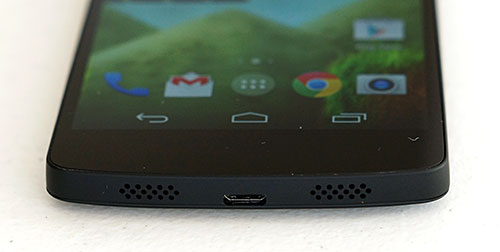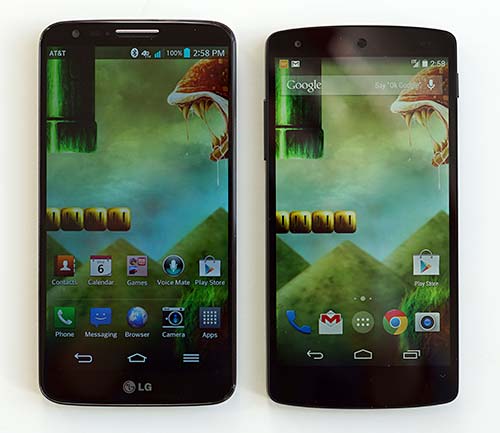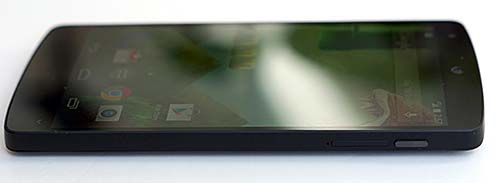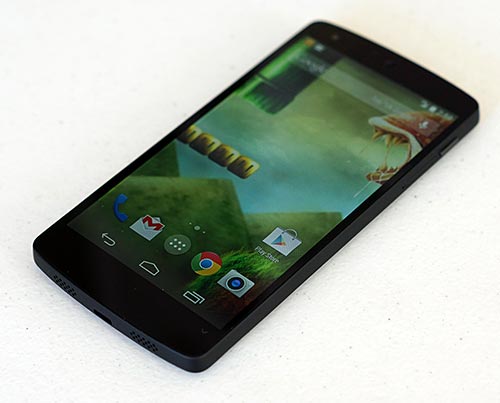Horsepower and Android OS 4.4 KitKat
It's a really, really fast phone; that's the condensed version. The Nexus 5 runs on a 2.26GHz Qualcomm Snapdragon 800 quad core CPU with Adreno 330 graphics, which is currently one of the top mobile CPUs on the market and the best Qualcomm offers. It runs circles around the HTC One and Samsung Galaxy S4 on synthetic benchmarks, and those are by no means sluggish phones. In a phone that mixes high end and midrange specs, the CPU and 2 gigs of RAM are high end stuff.
What makes the Nexus 5 feel faster is the pure Android build with no manufacturer overlays or customizations to slow things down. Android 4.4 KitKit is a sleek OS with improved memory management thanks to "Project Svelte". The phone does not lag; it flies. Demanding 3D games like Asphalt 8 looks great and runs smoothly. The Nexus 5 can play 4k video fine. In a world where high end smartphones become obsolete quickly thanks to crazy improvements in processing power, the Nexus 5 should hold up well a year from now, even if new phones with even faster specs make you feel like you're missing out. One thing that helps is the fact this is a Nexus phone, and that means you'll get OS updates first and you can generally count on two years of OS updates before Google adds software features that they think are too demanding for older hardware.
Though the Nexus lacks a microSD card slot, it does support USB host and with a USB OTG dongle we were able to use keyboards and mice. There's no OS support for removable mass storage like USB flash drives, so you'll need a third party utility like Nexus Media Importer (available on Google Play) for that.
Benchmarks
| |
Quadrant |
3DMark |
AnTuTu |
Sunspider JavaScript Test |
| Nexus 5 |
8808 |
17,828 (unlimited) |
27,017 |
718 |
| Samsung Galaxy S5 |
23,643 |
18,329 |
35,357 |
398 |
| LG G3 |
24,385 |
18,708 |
36,525 |
425 |
| HTC One M8 |
24,527 |
20,896 (unlimited) |
36,087 |
776 |
| Moto X (2nd gen) |
22,170 |
19,924 |
44,340 |
776 |
| Sony Xperia Z1S |
21589 |
16,135 (unlimited) |
35,008 |
837 |
| Moto G (2013) |
8485 |
2778 (extreme) |
17,396 |
1311 |
| Samsung Galaxy Note 3 |
22,006 |
15,092 (unlimited) |
35,823 |
587 |
| LG G2 |
19,762 |
9803 (extreme) |
32,990 |
823 |
| Samsung Galaxy S4 |
12,276 |
11,601 (unlimited) |
24,776 |
826 |
| LG Optimus G Pro |
11,994 |
N/A |
18,561 |
867 |
| Samsung Galaxy Note 2 |
6001 |
N/A |
14,056 |
1052 |
| Samsung Galaxy S3 |
5102 |
N/A |
7011 |
1825 |
3DMark, Ice Storm test (unlimited): 17,828.
Phone and Data
So this is a phone and you need to make calls, yes? We tested the Nexus 5 on AT&T's network in the Dallas area, where the carrier has excellent coverage and strong LTE 4G. Voice quality was good for both incoming and outgoing voice. The earpiece is reasonably full though the dynamic range isn't as good as the Galaxy S4 and volume is adequate. Incoming voice sounded natural with no DSP robotic distortion and call recipients could hear us clearly.
Data speeds on AT&T's network were par for the course among current LTE smartphones, which is to say excellent. We got as high as 28 Mbps down and 16 Mbps up according to the Speedtest.net app. We averaged 17 Mbps up and 12 Mbps down, and that means fast web page and email downloads, quick Google Play app downloads and fast WiFi mobile hotspot service for your laptop or tablet.
Camera
Here's where the midrange specs come in. The Nexus 5 has a front 1.3MP camera that's decent but not as sharp and bright as the higher resolution front cameras on the LG G2, HTC One, Samsung Galaxy Note 3 and Galaxy S4. The iPhone 5s with its similar resolution front camera does a better job thanks to enlarged sensor pixels. It's good for video chat, but not stellar.
The rear camera... ouch. The good news is that Google could fix this with a firmware update, but the bad news is they'll likely only fix some of what's wrong. The 8MP camera obviously isn't going to win resolution wars or pixel size battles. 8MP with standard pixel sensors is so last gen. Still, LG makes some excellent phone cameras, and the Nexus 5 could be a pretty decent shooter. Focus times are sometimes (though not always) oddly slow and the camera refocuses randomly in a way that reminds me of a drunk walking down a dark alley. Really Google? Forget capturing your energetic toddler or crazed kitty in photos or full HD video because it's hit or miss. Color reproduction is very good but highlights are sometimes blown out and both yellows and reds tend to bloom. These issues could be fixed with a software update and likely will be. The new HDR+ mode helps bring life to dark areas and we left it on most of the time (the processor is fast enough to make HDR+ processing quick). Optical image stabilization means no jumpy video footage--excellent! The camera really has promise because we did manage to capture some very sharp and colorful images when focus behaved, and macro shots are particularly good. The LED flash is weak and didn't help much with low light shots, and we found overall that this has the potential to be a very solid camera in good light, but we're not so sure about low light.
Here's the part Google probably won't fix, because they have an insane idea of what a camera user interface should look like. We haven't been a fan of the Nexus camera app for the past few iterations, and this has to be the worst. You start with a big viewfinder and no obvious hint on how to get to settings like the big gear that most phones use or Google's own Android settings symbol. You'll see a small icon labeled HDR+/geotagging and other for switching between 360 pano, standard panorama/photo/video. When in doubt, start swiping madly. You'll discover that swiping up from the bottom of the screen brings up a variety of settings using Google's circular UI (that should die a thousand deaths). Alternatively you can tap the HDR+/geotagging icon to bring up the top level settings menu. Most of the time when you try to use your fine motor skills (you need astronaut level skills here) to pick and swipe through one of the sub settings from the main settings arc, you'll select the wrong thing. It's like playing Whack a Mole. We don't always praise Samsung and their software, but Google should take a look at Samsung's excellent camera application for inspiration. Heck, even LG's own camera UI is pretty darned good.
Though the camera lacks filters and effects, Google's Photos app offers a nice selection of filters and basic editing features so you can add effects after you've taken a photo. On the software topic, but unrelated to the camera, it used to be when you got a Nexus device you had to buy your own MS Office compatible suite. Now that Google owns QuickOffice, that's no longer the case so you can view, edit and create MS Office documents out of the box.
Battery Life
The Nexus 5 has a 2,300 mAh Lithium Ion battery that's sealed inside. Sadly, we don't get the huge 3,000 mAh battery used in the LG G2 here. But for $349, don't expect all the features of the more expensive G2. Still, the Nexus 5's capacity is similar to the Galaxy S4 and HTC One, though those two phones run on slower processors. In our tests, battery life has been tolerable, and with light to moderate use we made it from 8 am to 8 pm before the battery went down to 15%. That's not as good as the Nexus 5's main competitors however; a point against the phone. The Nexus 5 supports Qi wireless charging, for those who hate plugging in the charger. Simply rest it on a Qi compatible charging plate and it will charge.
We did have a problem with the phone draining quickly on the first day, and it turned out Android's mediaserver was to blame. This OS component scans internal and external storage (note, the Nexus doesn't have external storage) at intervals to ensure that your music, photos and videos appear in their respective apps. We'd only put 3 short video clips on the phone and no music, so there was little to scan and index. Chalk it up to a quirk or bug that we haven't seen since. If we do, we'll update this review.
Is the Nexus a Good Fit for You?
If you're an old hand at Android and want to customize the phone exactly as you see fit, rather than living with a manufacturer's vision, then the Nexus and pure Android are for you. If you want to install custom ROMs without voiding your warranty or fighting manufacturer locks, then the Nexus is for you. But if you're Joe or Jane average who doesn't want to spend too much money on a phone, and you really like those software and hardware features that HTC, Sony and Samsung bring to the table, the Nexus might not be for you. You won't get Samsung's nifty split window application view for multitasking, or the consumer IR remote that controls AV home theatre gear as on the top phones from those makers. There's no HTC Zoe for fun photo moments, and there's no amazing set of fun camera filters and effects like you get on the Xperia Z, HTC One and Samsung Galaxy S4 and Note 3. Tap to wake on the LG G2 or the Moto X's active notifications? You won't find those here. Certainly, there's no digital Wacom S Pen as you'd get on the Note and no quick access settings like the LG G2 and Galaxy phones. While some manufacturers hit overload with their software (LG and Samsung), for many folks that's still preferable to vanilla blandness and a lack of eye catching features that excite you about a smartphone. Android enthusiasts and tinkerers will take issue with this statement, but really pure Android isn't better for everyone.
Google does include one special UI feature on the Nexus 5 that it says won't be on other Android 4.4 KitKat builds: Google Now is your leftmost home screen, just like Blinkfeed takes your leftmost screen on the HTC One. I don't mind that since I use Google Now all the time (it's the heart and soul of Google-ness). KitKat will bring voice-activated search (you'll have to say "OK Google" to activate it). Unlike the Moto X (don't forget Google owns Motorola now), the Nexus 5 lacks a low power CPU core or DSP dedicated to listening, so this will only work when the phone screen is turned on and in the home screen.
Conclusion
The Nexus 5 isn't the best smartphone on the market. In fact, there isn't a "best phone", because folks' needs are different: some want a small phone, others want lots of software features and still others want a phablet or a pen. The Nexus 5 is undoubtedly the best smartphone you can buy for just $349 full retail. It has a great mix of features for the price including a very fast CPU, a sharp full HD IPS display and the promise of always running the latest OS. Its display isn't quite as good as the LG G2, HTC One and iPhone 5s in terms of colors and contrast, the camera can't compete with the Samsung Galaxy S4 or iPhone 5s and you won't get a fancy metal casing here, but for the price you get plenty for your money. If you want an unlocked phone that will work with most carriers, prefer a pure Android experience or want good developer support for custom ROMs, this is your phone.
Website: play.google.com
Price: $349 for 16 gig and $399 for 32 gig
Related Reviews:
Nexus 6 Review
Moto X (2nd gen) Review
Moto G Review (2nd gen)
HTC One (M8) Review
LG G3 Review
Samsung Galaxy S5 Review
Sony Xperia Z3v Review
Sony Xperia Z3 Compact Review
Samsung Galaxy S5 Active Review
HTC One E8 Review
Samsung Galaxy S5 Sport Review
|


The LG G2 and Nexus 5.



|

